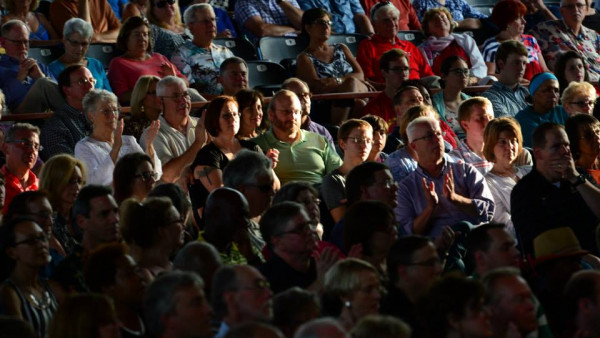Marsalis and JALC in warm surroundings in Skokie
The Jazz at Lincoln Center Orchestra has performed often in the Chicago area since 1992, the year of its first national tour – when it was called the Lincoln Center Jazz Orchestra and presented a compelling all-Ellington program in Orchestra Hall.
But never has this formidable ensemble played the intimate space it visited on Friday night. The opportunity to hear the band, led by Wynton Marsalis, in the close confines of the North Shore Center for the Performing Arts in Skokie (which seats a little over 800) not surprisingly drew a capacity audience to the first of two sets.
For those accustomed to hearing these musicians in spacious Orchestra Hall (which seats about 2,500), the Skokie concert offered an enticing alternative. Listen closely, and you could hear the inner workings of an elite ensemble.
The evening opened with a welcome tribute to Ornette Coleman, the fearless jazz innovator who died June 11, at age 85. Marsalis’ orchestral arrangement of “Ramblin’,” from Coleman’s landmark “Change of the Century” album (1960), brought startling textural transparency to an organization better known for its deep-blue instrumental colorings and lusty orchestral climaxes. The gentle sway and breezy ensemble phrasing of this performance captured the spirit of Coleman’s composition, while Elliot Mason’s full-throated trombone solo, alto saxophonist Sherman Irby’s sighing blues lines and Ali Jackson’s ringing, ultra-vivid percussion sharpened the edges of this reappraisal of “Ramblin’.”
Surely there’s no large ensemble working today that dispatches swing-era tours de force as authoritatively as the Jazz at Lincoln Center Orchestra, and the band underscored the point with a hyper-virtuosic reading of Eddie Durham’s arrangement of Rodgers and Hart’s “The Blue Room.” The cascading-horns effects, meticulous voicings and ever-thickening instrumentation would have been a challenge to pull off even at a less aggressive tempo than Marsalis chose. Add to this shimmering ensemble colors and thoroughly idiomatic solos – including a rhythmically playful statement from Marsalis via Harmon-muted trumpet and soaring clarinet lines from Ted Nash – and you had a reading about as close to the spirit of 1930s, Kansas City-swing as one could hope to encounter at this late date.
The myth that Marsalis and the Jazz at Lincoln Center Orchestra dwell on early-period repertoire somehow persists, but this concert (and many others) argued persuasively to the contrary. Wayne Shorter’s “Armageddon,” from his “Night Dreamer” album (1964), yielded radiant ensemble sound in trumpeter Marcus Printup’s Technicolor arrangement, with a searing solo from Printup and an extended essay from altoist Irby.
Like Marsalis, woodwind player Nash writes expansive works, and an excerpt of Nash’s “The Presidential Suite” (2014) provided one of the evening’s more stirring moments. “The Time for the Healing of the Wounds Has Come” was inspired by a speech of Nelson Mandela, JALC trombonist Chris Crenshaw reciting some of Mandela’s poetic text with rhetorical flourish. The band provided jubilant South African dance rhythms, conveying a message of hope in the aftermath of tragedy.
Elsewhere in the evening, the pen of reedist Victor Goines conjured bright splashes of orchestral sound in “Limbo Jazz,” Goines’ take-off on the chord changes to “Tiger Rag” (Goines also serves as director of jazz studies at Northwestern University’s Bienen School of Music). And Vincent Gardner authored a devilishly complex arrangement of Oscar Peterson’s “March Past,” from the “Canadiana Suite,” pianist Dan Nimmer evoking Peterson’s feathery touch and mercurial figurations.
All of this set the stage for next month’s release of “Live in Cuba,” the ensemble’s first album on its new Blue Engine Records label, created to bring the band’s archival music into general circulation. If the sonic quality of the forthcoming recordings match the artistic level this orchestra has come to represent, there will be important listening ahead.
by Howard Reich
Source: Chicago Tribune

